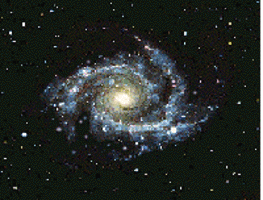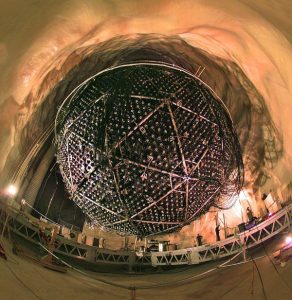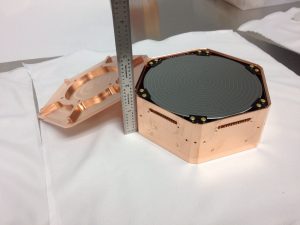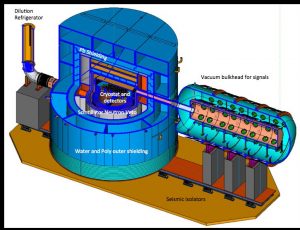It was back in my undergraduate days (early 1980s) that the topic of Dark Matter first began to be seriously considered by astro-physicists and cosmologists. The idea that there was some kind of matter in the Universe that was for some reason invisible to our telescopes was considered as a solution to two of the biggest problems in our study of the Universe.
The first problem concerned the stability of all of the rotating spiral galaxies we were studying. The idea that the stars in the outer reaches of a galaxy, like our own sun, would orbit around the center of the galaxy made perfect sense. After all, it was just Newton’s laws of gravity at work we thought. However, when we estimated the mass a galaxy, basically counting the numbers of stars, and measured the speed at which the stars were orbiting we found that there wasn’t enough mass, the galaxies should fly apart! There had to be some mass that we weren’t seeing, some invisible matter whose gravitational attraction was holding galaxies together. See image below.

At the same time other astronomers were studying the Cosmic Microwave Background (CMB), the leftover radiation from the original big bang, and used that data to calculate how the Universe should look today. Problem was that the calculations didn’t match the reality, not based on the amount of mass we could see. In order to make the calculations work the Universe had to have about four times as much invisible matter as the matter we could see.
O’k so the Universe had a lot of matter that didn’t emit light the way normal matter did in the stars, some sort of Dark Matter. The search was on to discover just what this Dark Matter was. The astro-physicists, with some help from the high-energy physicists, came up with a lot of ideas: Cold Dark Matter, Hot Dark Matter, MACHOS (Mass Concentrations) and WIMPs (Weakly Interacting Massive Particles).
That was almost forty years ago now, and we’re still waiting for direct experimental evidence of any kind of dark matter. Oh, we’ve made some progress, everybody pretty much agrees on WIMPs as Dark matter but that doesn’t mean everybody’s right. We need good hard evidence.
Hopefully soon we’ll get some from the Super Cryogenic Dark Matter Search now under construction by the Stanford Linear Accelerator Center (SLAC) at Stanford University and which will be set up over 2000 meters underground at SNOLAB at the Vale Inco Mine in Sudbury, Canada.
Setting up sophisticated, delicate physics experiments deep down in an old mine because all of the rock above the instruments helps insulate them from the interference of cosmic ray particles. And the SuperCDMS needs to eliminate all of the interference it can, it’s trying to measure the tiny amount of energy produced when a WIMP bounces against a normal atom. The image below shows the Sudbury neutrino telescope already in operation at Sudbury.

Physicists calculate that such collisions are very rare, you may have to wait many trillions of trillions of years for a particular atom to experience such a collision. Rather than waiting so long physicists will use trillion of trillions of atoms and then ‘listen’, that’s right listen for the sound of any collisions. Technically the intent is to detect the minute phonon signals of the collisions with germanium crystal detectors. The image below shows one of SuperCDMS’s detectors.

But in order to ‘hear’ the sound of a WIMP hitting an atom the physicists have to eliminate as much as possible the racket caused by all of the atoms hitting each other caused by thermal vibrations and the only way to do that is to reduce the detector’s temperature down to a small fraction of a degree above absolute zero, hence Super Cryogenic Dark Matter Search.
The experimental setup is shown in the image below. The cyrostat and detector section is modular in design allowing more detectors to be installed in the future. Around the detectors is a lining of lead (Pb) shielding with water shielding around that. The entire apparatus is then mounted on seismic isolators because even the slightest outside movement could be picked up as an erroneous signal. It’s often true that in today’s physics experiments, eliminating the unwanted signals can be a bigger job than detecting the minuscule signal you’re looking for!

SuperCDMS is scheduled to be up and running by the year 2020 but it will take four or five years of data collection before any results can be announced but I’ll let you in on my opinion. Now I’ll be very happy to be proven wrong but I’ve always been skeptical of WIMPs, we’ve been looking for them for forty years and have no evidence so far. Personally I was a MACHO supporter, basically the idea here was that for every star we can see there would be dozens of smaller brown dwarfs, objects just too small to start nuclear fusion and so don’t glow, and on top of that there would be literally thousands of planetary sized objects in interstellar space. I still think we need to consider MACHOS as a possible solution to the Dark Matter problem.
